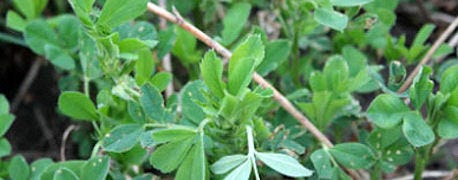May 19, 2013

Drought conditions last year and freeze/thaw cycles this spring damaged lots of alfalfa stands, says Justin Fruechte, forage and cover crop specialist with Millborn Seeds.
"Winterkill has either wiped out entire alfalfa stands or left them quite sparse," he says.
For sparse alfalfa stands that growers plan to cut for haylage, Fruechte recommends interseeding the stand with Italian ryegrass.
A cool season annual, Italian ryegrass is easy to establish and, like alfalfa, it is highly digestible with excellent levels of crude protein. Italian ryegrass also regrows quickly for multiple cuttings, he says.

Plant Italian ryegrass for haylage; teff grass for hay
"Italian is an excellent option that will thicken up the stand and allows for multiple cuttings," Fruechte says.
If wet conditions prevent growers from interseeding this spring, another option Fruechte suggests is the warm season annual, Teff grass.
Growers can interseed Teff grass in early June, once the soil temperatures reach at least 60 degrees. A fine-stemmed grass, Teff is highly digestible and is a quick regrowth, forage hay option.
Set The Schedule For Hay Quality. Deciding when to make the first cutting of hay sets the stage for the rest of the year. Download our FREE report Bailing Up Hay-Making Costs: A Buyer's Guide today.
~~~PAGE_BREAK_HERE~~~
"Teff grass is also good for growers who are still looking to cut hay," he says
Replant options
If the alfalfa stand is beyond repair, Fruechte recommends replanting the entire stand to cereal grains like oats, forage barley or triticale.
"Cereal grains are a quick growing forage option that will meet growers' forage yield needs and allow for alfalfa to be planted back to that field in the fall. " he says..
Thickening stands
Overseeding alfalfa stands over one year old with additional alfalfa seed is not recommended due to the likelihood of autotoxicity issues, according to University of Wisconsin research. Several other forage species have been utilized for thickening existing alfalfa stands, including cereal grains (oats, beardless barley, wheat, triticale); annual and perennial ryegrasses; sorghum-sudangrass; orchardgrass; and red, berseem and ladino clovers. Choice of species to overseed into alfalfa depends on the desired forage quality, yield, and length of stand extension needed.
Overseeding with legumes such as red clover will result in a high quality product suitable for lactating dairy cattle when harvested at the appropriate stage (bud – <20% bloom). Unless harvested early (boot stage), overseeded cereals and grasses may result in a slightly lower quality forage, but will provide adequate tonnage and nutrients for dry cows, bred heifers and other livestock.
Grasses overseeded into alfalfa stands generally produce higher yields of forage than overseeded legumes, so should be considered if higher yields are important. Adding a perennial species such as orchardgrass is useful if extending the stand life beyond the current growing season is desired. Annual grasses and cereal grains provide tonnage early in the growing season, but decline by mid-summer. They would be an appropriate choice for a stand that will be taken out for a late summer seeding after one or two cuttings.
Learn more
To learn more, contact Fruechte at 888-498-7333 or [email protected] and visit, www.millbornseeds.com.
Source: Milborn Seeds, University of Wisconsin
Set The Schedule For Hay Quality. Deciding when to make the first cutting of hay sets the stage for the rest of the year. Download our FREE report Bailing Up Hay-Making Costs: A Buyer's Guide today.
You May Also Like




